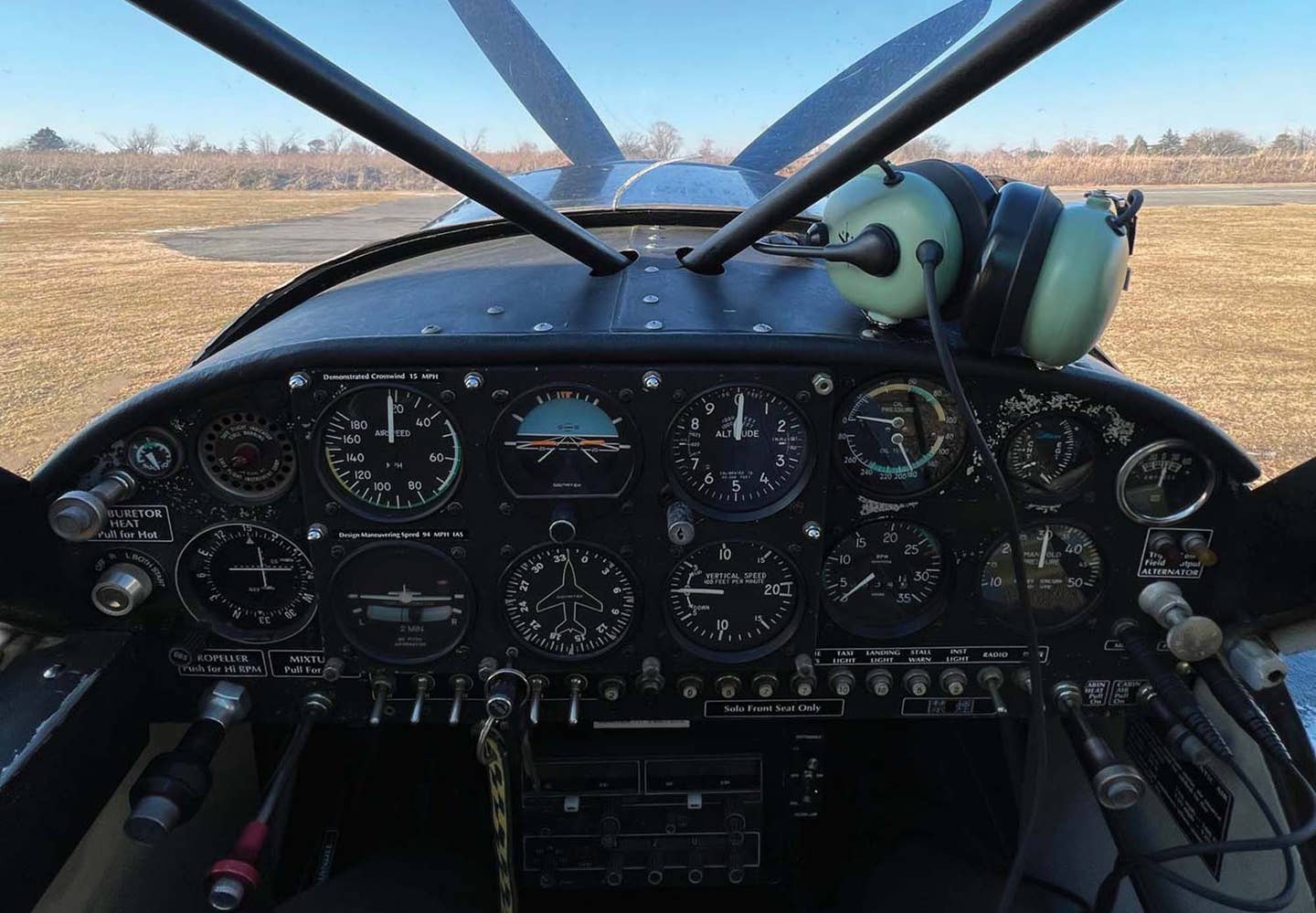ATC Communications: What to Say, and When
Improve air safety with this ATC communications cheat sheet, including practical tips & equipment suggestions for more efficient interactions.

[Image: Adobe Stock]
Before I started flight school, I went on a discovery flight at a local towered airport. I generally knew what to expect since this was not my first time in a small airplane. As a kid, I had the chance to ride in an old Piper Cub from a grass strip a few times. But I quickly realized that something was very different about this flight.
Before we got started, the instructor sitting beside me keyed up the radio and rattled off an incoherent string of words and numbers. An indistinct voice in my cheap rental headset quickly said something else that I could barely make out. More chatter from the right seat was followed by tinny gargling from the voice in my headset. It seemed to continue this way until we finally rolled onto the runway and got to the good part.
If there was one thing that shook my nerves every time as a beginning pilot, it was talking to ATC. Controllers spoke quickly and used unfamiliar words and phrases. I struggled in the early days just to understand them. Forget about responding to them without my instructor jumping in to save the day!
Thankfully, as many pilots are quick to discover, radio comms are not really as intimidating as they seem. Talking with ATC became second nature in no time with some focused study and practice. ASA Airplane Flying Handbook can be a great resource.
Basics of Radio Communications With Air Traffic Control
The guiding principle of ATC communications is understanding. Using the same verbiage in the same ways with brevity and clarity goes a long way in ensuring that everyone is “speaking the same language.” Clear and concise communication keeps radio frequencies clear and should be everyone’s aim. Plus, we’ll all sound like pros if we do it well.
Even so, no pilot should ever hesitate to ask for clarification if something does not make sense. Because the highest goal is understanding, never forget that it is okay to ask questions and even fall back to plain English if that is what it takes. Avoiding a little embarrassment is not worth a communication breakdown.
Standard Phraseology and Timing
The sort of communication we aim for requires a few basic ingredients. To be both concise and properly understood, pilots and controllers utilize standardized, shared terminology to the fullest extent possible. By mastering a common vocabulary, both sides can usually communicate what needs to be said in as few words as possible, freeing up valuable airtime and enabling quick action.
In addition to utilizing standardized verbiage, nearly all radio calls also follow a simple formula:
- Who you are talking to
- Who you are
- Where you are
- Any required reporting/your request
- Listen to ATC’s response
- Read back ATC’s response
Let’s take a look at some sample ATC communication.
Say you are approaching the Grand Prairie Municipal Airport from the south in a Cessna 12345 and want to make a full stop landing. You check the weather, get information Charlie, and then tune up tower frequency. Your call will sound something like this:
“Grand Prairie Tower, Cessna 12345, ten miles south with Charlie, landing full stop.”
The controller’s response will follow the same basic structure; he will say who he is talking to, who he is, and what he needs to tell you. So, Grand Prairie Tower’s response might go like this:
“Cessna 12345, Grand Prairie Tower. Enter left downwind Runway 18, report midfield.”
This initial exchange is not quite done, though. ATC needs to know if you heard and understood the instructions correctly, so you need to “read back” what was said:
“Enter left downwind Runway 18, report midfield, Cessna 12345.”
Notice in this scenario that the controller used the pilot’s full call sign (Cessna 12345) rather than abbreviating it, as is often the case after initial contact (Cessna 345). A pilot must use her full callsign on initial contact and continue doing so until ATC abbreviates it. This is usually to avoid confusion with other aircraft in the area with similar aircraft call signs.
After you land, the controller might choose to pass you off to Grand Prairie’s ground control frequency by saying the following:
“Cessna 13345, contact Ground, 121.15.”
Simply read back the instruction and switch frequencies. Avoid interrupting someone on the new frequency by listening for a moment before making an initial call. Simply follow the same structure as before: say who you are talking to, who you are, where you are, and what you want to do next.
Other ATC communication examples, such as handoffs between other types of controllers (e.g., from one center controller to another) will generally begin the same way. A departure controller might instruct a pilot to contact X Center on the appropriate frequency. The only real difference from the pilot’s perspective is that she does not usually need to state any intentions when making her initial call to the new controller.
“Fort Worth Center, Cessna 12345, level (or climbing/descending) 6,500 feet.”
ATC Communications Cheat Sheet
Beyond sticking to this basic formula, much of what is said on the radio is just plain English in abbreviated form. Below is an abridged glossary to help get you started. For a full resource, take a gander at the FAA’s Pilot/Controller Glossary.
ATC Formula:
1)Who you are talking to
2) Who you are
3) Where you are
4) What you want
5) Listen to ATC’s response
6) Read back ATC’s response
| Term | Meaning |
| Abeam | Aircraft is ~ 90 degrees to the right or left of a physical reference |
| Abort | Terminate a preplanned maneuver |
| Acknowledge | Let me know that you received and understood the message |
| Advise intentions | Tell me what you plan to do |
| Affirmative | Yes |
| Back taxi | Taxi aircraft on runway opposite to traffic flow |
| Cleared | ATC authorizes a specific action |
| Cleared for the option | Aircraft cleared to make touch-and-go, low approach, missed approach, stop and go, or full stop landing at pilot’s discretion. |
| Closed traffic | Aircraft does not plan to leave traffic pattern |
| Go ahead | Proceed with your message – does not refer to any movement. |
| Go around | Abandon approach to landing; additional instructions often follow |
| Have numbers | Used by pilots to inform ATC that they have runway, wind, and altimeter information only |
| Hold short | Do not cross |
| Ident | Activate transponder identification feature |
| LAHSO | Land and hold short |
| Make short approach | Alter traffic pattern to shorten final approach |
| Mayday | The international radiotelephony distress signal. Repeat 3x to indicate imminent danger and need for assistance |
| Monitor | Listen on specific frequency and stand by; do not establish communications |
| Negative | “No” or “permission not granted” or “incorrect” |
| Negative contact | Informing ATC a) traffic not in sight or b) unable to contact ATC on another frequency |
| Pilot’s discretion | Pilot can start climb or descent when and at whatever rate he/she wishes and may temporarily level off. Cannot return to a vacated altitude |
| Radar contact | ATC has identified an aircraft and flight following will be provided until radar contact terminated |
| Radar service terminated | Pilot will no longer receive services associated with radar contact |
| Read back | Repeat my message back to me |
| Report | Advise ATC of specified information |
| Resume own navigation | Pilot may resume own navigational responsibility after completion of vectoring or when radar contact is lost during vectoring. |
| Runway heading | When cleared to “fly runway heading,” pilots will fly a heading corresponding with extended centerline of departure runway |
| Say again | Request to repeat last transmission |
| Squawk | Enter following code into your transponder |
| Stand by | Instruction to wait momentarily |
| Traffic in sight | Informs ATC that pilot sees previously issued traffic |
| Traffic no factor | Traffic described in previous traffic advisory does not pose a conflict |
| Unable | Indicates inability to comply with specific instruction, request, or clearance |
| Verify | Request confirmation of information |
| When able | Pilot must comply but may delay until first opportunity to comply |
Practical Tips for New Pilots
New pilots can absolutely be effective communicators. Thought out, professional-sounding radio communication comes with practice, planning, and good resource management.
Make note while planning of which frequencies a flight will likely utilize well before taking off. Consider what calls might come up given the route of flight and the types of airspace and weather it might pass through. Stay ahead of the airplane in-flight to give yourself time to think and to free yourself for jotting down notes as needed. Have a backup plan in case you lose comms – a handheld radio in your bag is a wise place to start. I always carry mine, and yes, I have had to use it.
Make it a point to tour a local ATC facility. Take the opportunity to meet some of the controllers and put names and faces to their voices. These incredible people are usually happy to show you what happens behind the scenes and provide more insight into how pilots and controllers can work better together.
How to Get ATC Communication Practice
Communicating with ATC can feel a bit like speaking a foreign language at first. Along with beginning each flight well-prepared, the best tool in any pilot’s arsenal is practice. Review online ground school resources. Practice making mock radio calls while flying a home flight simulator. Make those practice calls even more realistic by utilizing live air traffic controllers who can help simulate real interactions.
Pilots should also take full advantage of free reference materials like the FAA’s Aeronautical Information Manual (AIM). Chapters four and five are the best starting point for learning how to interact with ATC. Take this knowledge and listen to online ATC radio feeds to get used to hearing and understanding the lingo in a live environment.
Mission-Critical Aviation Comms Equipment
Knowledge and preparation make for smooth ATC communication, and part of being prepared is having equipment fit for the job. Though I love my David Clack DC ONE-X, new student pilots need not worry about getting top dollar headsets. They should look for quality. Nothing undermines clear communication more than not being able to hear what ATC is saying. Asking other pilots which headsets they like and doing some research can help you get a comfortable set that makes it easy to hear and be heard clearly.
In addition to your aircraft’s installed radio systems, handheld radios provide an important layer of safety and redundancy in case of radio failure. There are a wide variety of options on the market, ranging from simple radios to units with GPS/VOR navigation features and full ILS capabilities.
Build Good ATC Communications Habits
FAA manuals may not be the most riveting reads. However, out of all the excellent resources available to pilots, these are the ultimate source of information on the American ATC system. Take time to review resources like the Pilot/Controller Glossary, Pilot’s Handbook of Aeronautical Knowledge, and the Aeronautical Information Manual.
With this knowledge base in place, move on to study and practice tools to help solidify that foundation. Once ready to practice in the air, come to each flight prepared with thorough plans and the right equipment. Talking to ATC in the real world is the absolute best way to get better.
So, get in that plane. Think through what you will say. Take a deep breath. Key up the mic. Now speak!
FAQ
How can I learn ATC communication?
Start with FAA materials like the Pilot/Controller Glossary and Aeronautical Information manual, then review using resources like an online ground school. Practice listening to online ATC feeds, making mock calls while piloting a flight simulator, and reviewing what you know on a flight with an instructor.
How can I listen to ATC conversations?
Several websites provide links to live ATC audio feeds from across the world.
How do I practice talking to ATC?
Popular flight simulation software usually comes with some form of built-in ATC functionality, although pilots can enhance simulated ATC practice with live resources like PilotEdge. Flight instructors and study groups provide further options for practice.

Subscribe to Our Newsletter
Get the latest Plane & Pilot Magazine stories delivered directly to your inbox






